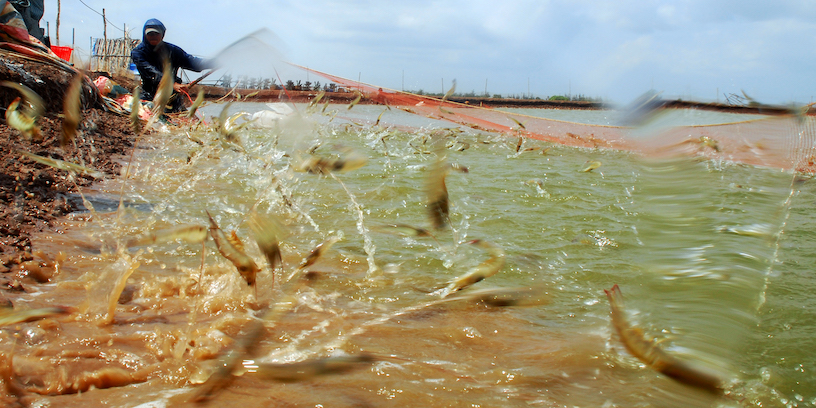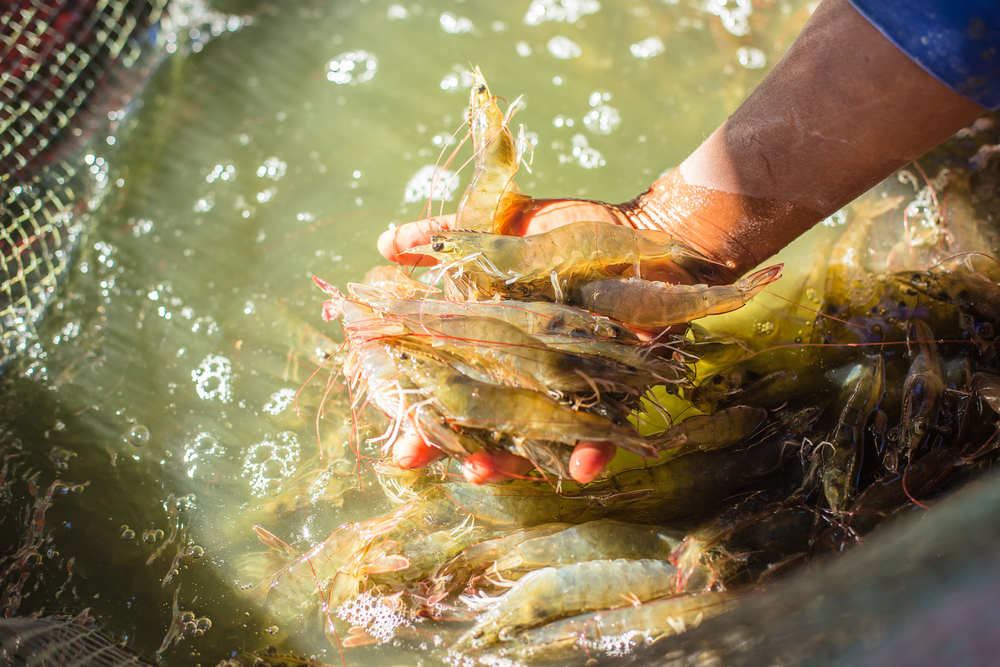Going back to the past, shrimp farming probably officially started when Japanese scientist, Motosaku Fujinaga, first bred and artificially hatched white vannamei shrimp in tanks in 1933. Fujinaga is considered the father of the industry. shrimp farming using techniques he discovered, including using Artemia eggs ( brine shrimp) as food. Since then, shrimp began to be raised more to meet consumer demand in Japan, the US and many other Western European countries, especially since the 1970s.

Shrimp Farming – Challenges and Opportunities
By 2003, shrimp farming was a $9 billion industry with an output of more than 1.6 million tons. By 2017, the total pond area was 2,124,110 hectares, and the shrimp farming industry had an output of 4.2 million tons and was valued at $23.6 billion as a whole (according to a report by the Farming Alliance of. Global Aquaculture). Southeast Asian countries (Vietnam, Thailand, Indonesia, …) contributed the most output (36.9%) and followed, respectively, China (31.6%) and India (11.9%). 6%). Among them, vannamei shrimp is the most commonly farmed variety, with 80% of the total global production coming from farming and valued at US$18,460 million in 2014.
The value of shrimp has gradually increased in the list of aquaculture species, surpassing tilapia and now second only to carp. However, parallel with this outstanding development also arise problems, especially the spread of disease. In Asia alone, shrimp viruses have cost farmers nearly $1 billion a year since 1994. This creates challenges that need to be addressed to improve industry efficiency.
Risk of infection
In the wild, shrimp also carry viruses that cause disease but usually do not affect their health much. But when kept in a crowded environment, they can be stressed and susceptible to diseases from potential viruses. Or when the water source is not treated well, it is easy to create opportunities for viruses from outside to enter and cause disease in shrimp ponds. When diseased shrimp mortality, they will be eaten by healthy ones, causing the disease to quickly spread to the whole pond population. This is a problem that has plagued the shrimp farming industry for decades. In particular, early mortality disease, also known as acute hepatopancreatic necrosis disease (EMS/AHPND) and Hepatopancreatic Microsporidiosis, are the two most frequently occurring diseases.
However, despite the continued threat of disease outbreaks over time, statistics show that the global shrimp farming industry can cope with this problem even if production is tripled or quadrupled times more. We have done it and can do better if we can coordinate the whole industry to recognize and find ways to handle this epidemic problem.
Food source
Another big problem is the limited supply of quality aqua feed. In the past three decades, along with the proliferation of farms, the demand for feed used in aquaculture has also increased sharply. However, only about 4% of total animal feed production worldwide is produced for aquaculture. This will be an important issue if the shrimp farming industry wants to expand its production scale because it needs to negotiate and coordinate with other industries, especially the terrestrial industries. Increased production of crops such as soybeans, animal by-products, as well as further research into new forms of bacterial and insect production is needed if increased production of aquafeeds is to be achieved. shrimp farming activities.
Biological safety
Another alarming problem is the overuse of antibiotics and chemicals in shrimp farming. Because when farming in the form of intensive farming, shrimp farmers often have the habit of using antibiotics and chemical products to prevent and treat shrimp diseases. However, this adversely affects the quality of shrimp in particular, and the environment in general, because there are too many antibiotics and chemicals left after harvest. To overcome this problem, probiotic technology with products from beneficial bacteria is an effective option to both maintain production and ensure quality for commercial shrimp. The application of microbial preparations has been proven to bring a number of comprehensive and great benefits such as: increased absorption, development, disease resistance, increased survival rate; improve productivity, quality, reduce environmental pollution from production activities, and at the same time save investment costs for farmers.

Applying probiotic technology to make shrimp healthier and cleaner
In addition, sustainable farming forms such as ecological shrimp farming, shrimp-forrest combination, shrimp-rice is also a development direction that needs more research and investment to improve the value of shrimp. and seek sustainable development.
The future of shrimp farming
We’ve done a great job of increasing global shrimp production four times from 1995 levels. To continue that expansion, while at the same time achieving greater efficiency, we need coordination and application. rationalize modern technical technologies into each segment. In the breed segment, the application of genetic technology has improved and selected shrimp varieties with better disease resistance and faster growth. In the nursery segment, shrimp hatcheries can enhance live feed substitution and biosecurity to ensure input quality.Grow-out segmentation must reduce rearing time through selective breeding, improving production management, efficiency, biosecurity, health management and survival. At the same time, it is necessary to expand knowledge of shrimp nutrition, to choose the right feed and functional foods (seasonal, anti-stress, immunomodulatory) and to distribute/manage the correct feeding and reasonable. Other areas of improvement include better pathogen detection, efficient use of immunostimulants and probiotics, and even packaging and processing of finished products.
Most importantly is to understand and meet the growing consumer expectations of healthy, sustainable and responsible food. The shrimp industry has significant potential to expand global production, and we can realize that potential by enhancing responsible production technologies and processes.